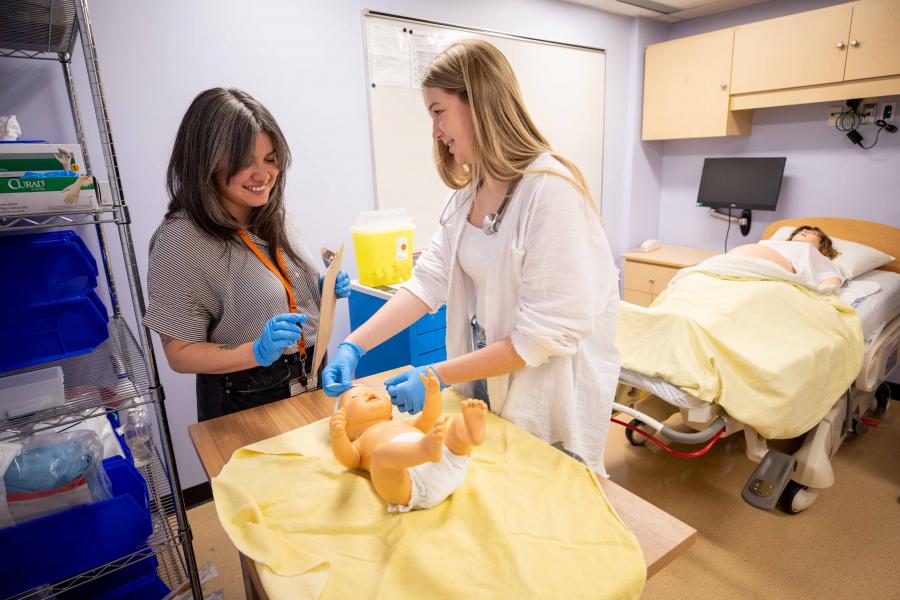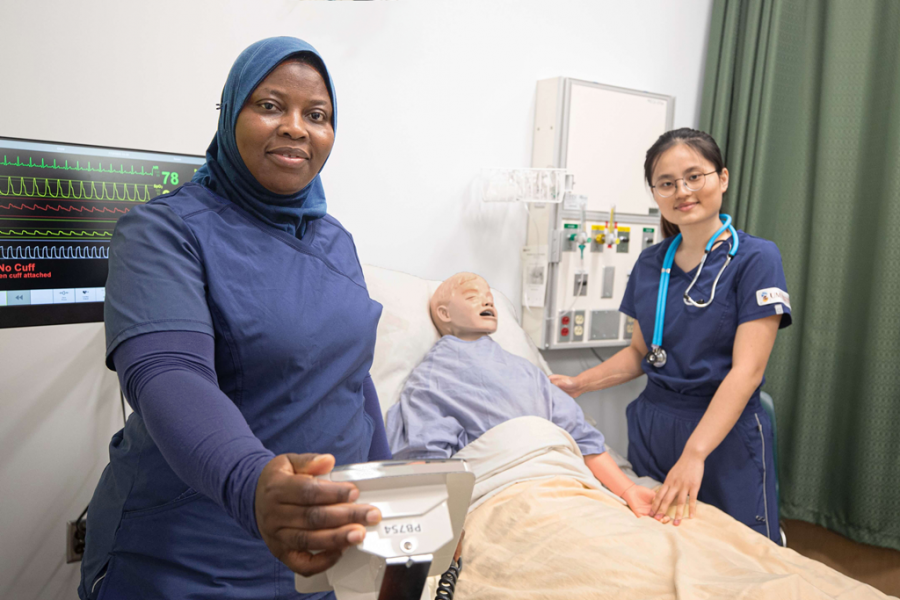College of Nursing
Programs of study
The College of Nursing has a proud history of providing top-notch nursing education, supporting student success, and advancing research and scholarship. Our commitment extends to enhancing health care quality in Manitoba and beyond. Here, you’ll experience a learning environment that blends simulation, interprofessional education, and innovative learning models to prepare you for a successful career in nursing.
Undergraduate programs
Pre-nursing
Indigenous applicants — Pathway to Indigenous Nursing Education
Requirements to apply into a nursing undergraduate program
Adjusted Grade Point Average cut-offs
Admission AGPA from previous terms for domestic and international applicants to the BN Program
| Fall 2025 | 3.555 |
| Summer 2025 | 3.1033 |
| Winter 2025 | 3.235 |
Before you apply
To succeed in the program and graduate, you’ll need to meet both the academic standards and the necessary skills and abilities. Before applying, take a moment to review the Requisite Skills and Abilities for the Bachelor of Nursing Program Policy or the Requisite Skills, Abilities, and Standards for Capacity for the Bachelor of Midwifery Program. You can find detailed information in the sections below to help you determine if you’re ready to take the next step.
Requisite skills, abilities and standards for capacity for the Bachelor of Midwifery Program
|
Policy name |
Requisite skills, abilities and standards for capacity for the Bachelor of Midwifery Program |
|
Application / scope |
Staff, faculty members and students of the Bachelor of Midwifery Program, College of Nursing |
|
Approved date |
May 14, 2020 |
|
Revised date |
|
|
Approved by |
College executive council/college council, College of Nursing April 17/29, 2020 |
1. BACKGROUND
1.1 Midwifery education requires that the accumulation of scientific knowledge be accompanied by the simultaneous development of specific skills and other competencies.
1.2 All graduates of the Bachelor of Midwifery Program (“Program”) must have the knowledge, skills and other competencies to function in a wide variety of clinical situations and to render a wide spectrum of client care. The Program has been structured as a broad general professional education. The academic standards and standards for capacity are based on that model and the standards are set to insure capable, well-rounded future clinicians that will meet the requirements for entry to practice as established by the midwifery regulatory body in Manitoba, the College of Midwives of Manitoba (“CMM”). All midwifery practitioners must be registered with the CMM in order to practice in the province.
1.3 All students of the Program must meet both academic standards and standards for capacity in order to progress through the Program and graduate.
1.4 Without meeting the standards for capacity, students cannot fulfill the requirements of all the courses and clerkships in the Program. Meeting the Standards for Capacity is, therefore, required for:
- matriculation (insomuch as the abilities can reasonably be determined before matriculation)
- subsequent promotion from term to term
- graduation from the Program
2. REASON FOR POLICY
2.1 To set out the requisite skills, abilities and standards for capacity for the Bachelor of Midwifery Program.
3. DEFINITIONS
3.1 Academic Standards: the acceptable demonstrations of mastery in the Program in various disciplines, before matriculation and after, as judged by faculty members, examinations, and other measurements of performance. Acceptable levels of mastery are required and based on the Canadian Midwifery Regulators Council (CMRC), Canadian Competencies for Midwives document. The following are the required eight specific areas of core competency once a student matriculates in the Program:
- Antepartum care
- Care during labour, birth and the immediate postpartum period
- Care of the client during the postpartum period, including breast/chest feeding
- Care of the newborn and the young infant
- Education and counselling
- Professional development
- Professional, inter-professional, legal and other aspects of the profession
- Well-client care, sexuality and gynecology
Academic Standards, and related grading systems, are addressed in detail during each academic and clinical course. Any student, who has specific questions about performance requirements, may speak with tutors or course coordinators.
3.2 Standards for Capacity: also known as technical standards or requisite skills and abilities, they are the essential aptitudes and abilities that allow midwifery students (and midwives) to perform in the vast array of requisite ways summarized by the eight areas of competency above. These abilities are the foundation for academic success in the Program, and for the eventual practice of midwifery itself. The Standards for Capacity are further detailed in 4.1.
4. POLICY PROCEDURE AND STATEMENTS
4.1 Students in the Program must have the requisite Standards for Capacity in five broad areas:
- Perception/observation
- Communication
- Motor/tactile function
- Cognition
- Professionalism (mature and ethical conduct)
Students must be able to demonstrate competence where required in both classroom and in clinical practice settings, including critical and complex situations, in order to ensure the safety, health and well-being of the women and infants in their care.
A. Perception/observation
Students must be able to accurately perceive, by the use of senses and mental abilities, the presentation of information through:
- Small group discussions and presentations
- Large-group lectures
- One-on-one interactions
- Laboratory experiments
- Client encounters (at a distance and close at hand)
- Diagnostic findings
- Procedures
- Written material
- Audiovisual material
Representative examples of materials/occasions requiring perceptual abilities beginning in year 1 include, but are not limited to: books, diagrams, discussions, physiological and pharmacological demonstrations in animals, microbiologic cultures, gross and microscopic studies of organisms and tissues, chemical reactions and representations, photographs, x-rays, possibly cadaver dissections, live human case presentations, and client interviews. Students can expect to be exposed to noxious stimulae such as human body fluids.
Additional examples from year 2 include, but are not limited to: physical exams; pelvic exams; examinations with stethoscopes, fetoscopes; ophthalmoscopes, sphygmomanometers, and reflex hammers; verbal communication and non-verbal cues (as in taking a client's history or working with a maternity care team); live and televised procedures; childbirth; radiography (including ultrasounds), MRIs, and other diagnostic findings; online computer searches.
B. Communication
Students must be able to communicate skillfully (in English) with faculty members, other members of the healthcare team, clients, families, and other students, in order to:
- Elicit information
- Convey information
- Clarify information
- Create rapport
- Develop therapeutic relationships
- Demonstrate competencies
Representative examples of areas in which skillful communication is required beginning in year 1 and 2 include, but are not limited to: answering oral and written exam questions, eliciting a complete history from a client, presenting information in oral and written form to preceptors, participating in sometimes fast-paced small-group discussions/interactions, participating in group dissections, participating in clinical skills labs.
Additional representative examples of areas in which skillful communication is required in year 3 and 4 may include, but are not limited to: participating in clinical rounds and conferences; writing client histories and physicals; undertaking consultations with physicians and other professionals; communicating effectively with all members of the healthcare team; talking with clients and families about clinical issues; interacting in a therapeutic manner with clients; providing educational presentations to clients and families; participating in videotaped exercises; interacting with administrators; writing notes and papers.
C. Motor/tactile function
Students must have sufficient motor function and tactile ability to perform each of the following requisites well enough to provide client care and participate in educational activities:
- Attend (and participate in) all classes, groups, and activities which are part of the curriculum, including travel to provide antenatal, intrapartum and postpartum care
- Bend
- Carry objects
- Climb
- Demonstrate competencies
- Do basic laboratory procedures and tests
- Examine clients
- Function in the hospital, home and clinic venues
- Lift
- Manual dexterity
- Move within limited spaces
- Perform complex sequences of hand-eye coordination
- Perform diagnostic procedures
- Perform in a reasonably independent and competent way in sometimes chaotic clinical environments
- Perform repetitive movements
- Provide general and emergency client care
- Push and pull
- Reach
- Read and write
- Stand and maintain balance
- Walk
These competencies need to be attained even in situations where fatigue may be a factor, such as when taking overnight call.
Representative examples of activities/situations requiring students' motor/tactile function beginning in year 1 include, but are not limited to: transporting themselves from location to location; participating in classes, small groups, client presentations, review sessions.
Additional representative examples of activities/situations requiring students' motor/tactile function beginning in year 2 include but are not limited to: laboratory work, and microscopic investigations; using a computer; performing a complete physical exam - including observation, auscultation, palpation, percussion, and other diagnostic maneuvers; performing simple lab tests; using light microscopes; performing cardiopulmonary resuscitation, urinary catheterization, pap smears and vaginal sampling, suturing, venipuncture, IV cannulation and maintenance, injection of pharmaceuticals (including manipulation of small objects such as vials, glass ampoules), taking overnight call from home or clinic, staying on call for up to 24 hours at a time with the possibility overnight call in the hospital; performing physical, gynecological, newborn and obstetric examinations (with the appropriate instruments); dealing with agitated clients in emergency situations; maintaining appropriate medical records; acting as primary or backup midwife in the homebirth or hospital birth settings.
During years 3 and 4, the previously demonstrated skills will be practiced with more frequency and require following either a midwife, physician or other health professional demonstrating the same skills. Additional examples of experiences requiring motor/tactile function in years 3 and 4 include, but are not limited to: accompanying staff on rounds and conferences.
D. Cognition
Students must be able to demonstrate higher-level cognitive abilities, which include:
- Rational thought
- Measurement of clinical observations such as blood pressure
- Calculation for example performing calculation of drug dosages
- Visual-spatial comprehension such as understanding the mechanisms of labour
- Conceptualization
- Analysis
- Synthesis
- Organization
- Representation (oral, written, diagrammatic, three dimensional)
- Memory
- Application
- Clinical reasoning
- Ethical reasoning
- Sound judgment
Representative examples of applied cognitive abilities beginning in years 1 and 2 include, but are not limited to: understanding, synthesizing, and recalling material presented in classes, labs, small groups, client interactions, and meetings with preceptors; understanding 3-dimensional relationships, such as those demonstrated in the anatomy lab; successfully passing oral, written, and laboratory exams; understanding ethical issues related to the practice of midwifery; engaging in problem solving, alone and in small groups; interpreting the results of client examinations and diagnostic tests; analyzing complicated situations, such as cardiac arrest, and determining the appropriate sequence of events to effect successful treatment; working through genetic problems.
Additional representative examples of required cognitive abilities beginning in year 2 include, but are not limited to: integrating historical, physical, social, and ancillary test data into differential diagnoses and treatment plans; understanding indications for various diagnostic tests and treatment modalities - from medication to surgery; understanding methods for various procedures, such as pap smears and vaginal/cervical specimens, urinary specimens and inserting intravenous catheters; being able to think through midwifery issues and exhibit sound judgment in a variety of clinical settings, including emergency situations; identifying and understanding the variations of normal newborn and maternal physical examination, developing clear assessment and conclusions through analysis of objective and subjective data, formulation of plans of care which demonstrate primary care role of the midwife, making concise, cogent, and thorough presentations based on various kinds of data collection, including web-based research; knowing how to organize information, materials, and tasks in order to perform efficiently in providing care; understanding how to work and learn independently; understanding how to function effectively as part of a healthcare team.
Additional representative examples of required cognitive abilities in years 3 and 4 include, but are not limited to: identifying and understanding maternal and newborn complications during the antepartum, intrapartum and postpartum periods and understanding the need for consultation, confidently managing emergency/life threatening situations using emergency skills, such as, management of shoulder dystocia, postpartum hemorrhage, neonatal resuscitation, allergic anaphylaxis.
E. Professionalism: (Mature and Ethical Conduct)
Students must be able to:
- Consistently display integrity, honesty, empathy, caring, fairness, respect for self and others, diligence, and dedication
- Promptly complete all assignments and responsibilities attendant to the diagnosis and care of clients (beginning with study in the first year)
- Communicate with, examine, and provide care for all clients—including those whose gender, culture, sexual orientation, or spiritual beliefs are different from the students' own
- Develop mature, sensitive, and effective relationships, not only with clients but with all members of the midwifery school community and healthcare teams
- Maintain sobriety in all academic and clinical environments, and refrain from the illegal use of substances at all times
- Abide by all provincial and federal laws, hospital policies and all Bachelor of Midwifery Program and University codes of conduct
- Tolerate physically, emotionally, and mentally demanding workloads
- Function effectively under stress, and proactively make use of available resources to help maintain both physical and mental health
- Adapt to changing environments, display flexibility, and be able to learn in the face of uncertainty
- Take responsibility for themselves and their behaviors
Representative examples of professional behavior beginning in years 1 and 2 include, but are not limited to: showing up for required experiences on time and prepared; handing in assignments on time; refraining from plagiarizing or cheating; treating faculty, staff, and other students with respect; making an effort to understand prejudices and preconceptions that might affect client interactions or collegial relationships (especially in the areas of race and ethnicity, sexual orientation, gender, disability, age, and religious difference); developing successful working relationships with preceptors, staff, and peers by accepting constructive feedback.
Additional examples of professional behavior in years 3 and 4 include, but are not limited to: maintaining a professional demeanor on service (e.g. name tag, appropriate attire, hygienic and neat appearance, respectful speech, sobriety); representing oneself accurately; appreciating and preserving client confidentiality; responding sensitively to clients' social and psychological issues; developing empathic listening skills; understanding social biases and stigmas, and not reinforcing them; advocating for clients when appropriate; using hospital/clinic resources responsibly; showing up prepared and on time for rounds, lectures, conferences, and procedures; getting advice when handling ethical dilemmas; taking constructive feedback from attending midwives, physicians, nurses and tutors with open-mindedness and the intention to improve; contributing to the effectiveness, efficiency, and collegiality of healthcare teams.
4.2 All applicants to the Program are required to review this document to assess their ability to meet these Standards for Capacity. All applicants offered admission will be required to acknowledge such review and assessment.
4.3 Any student in the Program who cannot attain the Standards for Capacity through their course of study may be requested to withdraw from the Program.
4.4 On occasion, reasonable accommodations may be required by individual students to meet these Standards for Capacity. Requests for University-provided accommodations will be granted if the requests are reasonable, do not cause a fundamental alternation of the Program, do not cause an undue hardship on the University, are consistent with the standards of the midwifery profession, and are recommended by Student Accessibility Services of the University of Manitoba. The Program is required to follow the Accessibility Policy and Student Accessibility Procedure.
4.5 Students requesting accommodation shall register with Student Accessibility Services and follow the process in accordance with the University of Manitoba Student Accessibility Procedure. The Program will consider each student’s accommodation request in accordance with the University of Manitoba Student Accessibility Procedure. Given the clinical nature of the Program, additional time may be needed to implement accommodations. Accommodations are never retroactive; therefore, timely requests are essential and encouraged.
5. REFERENCES
5.1 Accessibility Policy, University of Manitoba
5.2 Canadian Competencies for Midwives 050505; Revised 101108, Canadian Midwifery Regulators Consortium
5.3 Essential Skills and Abilities (Technical Standards) for Admission, Promotion and Graduate in Medicine Policy, Max Rady College of Medicine, University of Manitoba
5.4 Essential Standards for Matriculation, Promotion, and Graduation, Dartmouth Medical School (content used and revised, with permission)
5.5 Representative Skills, Abilities, and Capacities for the Bachelor of Nursing Program, University of Manitoba (currently under revision)
5.6 Student Accessibility Procedure, University of Manitoba
5.7 Student Accessibility Services, University of Manitoba
6. POLICY CONTACT
Please contact the director, Bachelor of Midwifery Program, with questions regarding this document.
Requisite skills and abilities for the Bachelor of Nursing Programs
|
Policy name |
Requisite skills and abilities for the Bachelor of Nursing Program |
|
Application / scope |
Students of the Bachelor of Nursing Program, College of Nursing |
|
Approved date |
June 24, 2020 |
|
Review date |
June 24, 2025 |
|
Revised date |
|
|
Approved by |
College Council/College Executive Council, College of Nursing September 30, 2020 |
1. BACKGROUND
1.1 The Bachelor of Nursing Program, College of Nursing, is responsible to provide a program of study so that graduates are able to provide safe, compassionate and ethical nursing care consistent with entry-level competencies as defined by the College of Registered Nurses of Manitoba (CRNM).
1.2 Graduates of the Bachelor of Nursing Program must be able to serve the public by demonstrating accountable, ethical, and knowledge-based nursing practice. To achieve this goal, students in the Bachelor of Nursing Program will require appropriate knowledge, as well as cognitive, communication, social, motor and sensory skills to assess clients and to plan, implement and evaluate the necessary nursing care. Prospective candidates should be aware that cognitive, physical examination, management skills, communication skills, and professional behaviours are all evaluated in timed simulations of patient encounters.
1.3 By the completion of the Bachelor of Nursing Program, all graduates must demonstrate the capacity to meet the CRNM’s Entry-Level Competencies for Registered Nurses in Manitoba and be able to practice within the context of the CRNM’s Practice Expectations for RNs and the Canadian Nurses Association Code of Ethics for Registered Nurses.
2. REASON FOR POLICY
2.1 To set out the requisite skills and abilities for the Bachelor of Nursing Program.
3. POLICY AND PROCEDURE STATEMENTS
3.1 All students must have the ability to meet and demonstrate progression of the following requisite skills and abilities. The requisite skills and abilities are organized in five categories with examples of entry-level registered nursing activities to illustrate the requisite. The examples do not constitute the requisite skills and abilities in their entirety. They are included to provide a snapshot of the nature and kinds of activities involved in typical entry level registered nursing practice. Note: The examples are intended to mean “including, but not limited to” the particular examples provided. (Reproduced, with permission, from the CRNM’s Requisite Skills and Abilities document)
Requisite skill and ability examples:
Cognitive
Ability to perform skills which demonstrate thinking capacity:
- Recall information over time
- Demonstrate complex computation skills
- Demonstrate critical inquiry skills
- Prioritize tasks
- Demonstrate concentration skills
- Demonstrate problem-solving skills
Examples:
In administering a pain medication, critically analyzes patient assessment data (observation of the patient, recall from the past, recalls information from colleagues), chooses from possible interventions (amount of pain medication), calculates correct dosage, safely administers the medication, recognizes untoward effects and intervenes as necessary. Manage university level courses in nursing, the humanities, the physical, social, biological sciences and mathematics.
Communication
Ability to express and receive written, verbal or non-verbal information and the ability to interact with others in a clear, respectful and professional manner. This includes:
- English language proficiency (reading, writing, listening and speaking)
- Recognizing own non-verbal communication and the ability to interpret non-verbal communication of others
- Ability to document and understand information, in writing as well as electronically, in the patient’s chart/health record
Able to elicit and attend to information from a client during an assessment (both verbal and nonverbal communication) and communicate findings both verbally and in writing to other health-care providers.
Behavioural
Ability to conduct oneself in a professional manner:
- Accept individual differences
- Take direction
- Behave in a professional manner
- Practise in a manner consistent with established client safety policies and procedures
- Provide care in an unpredictable environment
- Manage time and establishes timelines
Sets priorities in the face of multiple demands. Maintains a calm presence with clients regardless of the clients’ behaviour. Behaviour demonstrates understanding of professional boundaries.
Sensory
Ability to perceive with each of the following senses well enough to provide care and participate in educational activities:
- Sight
- Touch
- Hearing
- Smell
- Hand-eye coordination (manual dexterity)
See well enough to read numbers and lines of demarcation on a syringe. Feel a pulse. Perceive differences in temperature with hand touch. Hear alarms on equipment, client call systems, hear through a stethoscope to note heart rate and breath sounds. Able to hear client’s voice without looking directly at them. Able to recognize abnormal odours. Able to prepare and administer a medication for injection.
Physical
Ability to perform each of the following requisites well enough to provide client care and participate in educational activities:
- Bend
- Carry
- Climb
- Lift
- Move within confined spaces
- Perform repetitive actions
- Push and pull
- Reach
- Stand and maintain balance
- Walk
Able to provide CPR to a client. Able to carry a baby scale up a flight of stairs for a post-natal home visit. Able to reposition a patient in bed. Able to move between a client’s bed and equipment or in a small space such as a client’s bathroom.
3.2 All applicants to the Bachelor of Nursing Program are required to review this document to assess their ability to meet these requisite skills and abilities. All applicants offered admission will be required to acknowledge such review and assessment.
3.3 Any student in the Bachelor of Nursing Program who cannot attain the requisite skills and abilities through their course of study may be required to withdraw from the program.
3.4 On occasion, reasonable accommodations may be required by individual students to meet these requisite skills and abilities. Requests for University-provided accommodations will be granted if the requests are reasonable, do not cause a fundamental alternation of the Bachelor of Nursing program, do not cause an undue hardship on the University, are consistent with the standards of the nursing profession, and are recommended by Student Accessibility Services of the University of Manitoba. The College of Nursing is required to follow the Accessibility Policy and Student Accessibility Procedure.
3.5 Students requesting accommodation shall register with Student Accessibility Services and follow the process in accordance with the University of Manitoba Student Accessibility Procedure. The College of Nursing will consider each student’s accommodation request in accordance with the University of Manitoba Student Accessibility Procedure. Given the
clinical nature of the program, additional time may be needed to implement accommodations. Accommodations are never retroactive; therefore, timely requests are essential and encouraged.
4. REFERENCES
4.1 Accessibility Policy, University of Manitoba
4.2 Entry-Level Competencies for Registered Nurses in Manitoba, College of Registered Nurses of Manitoba
4.3 Essential Skills and Abilities (Technical Standards) for Admission, Promotion and Graduate in Medicine Policy, Max Rady College of Medicine
4.4 Practice Expectations for RNs, College of Registered Nurses of Manitoba
4.5 Requisite Skills and Abilities, College of Registered Nurses of Manitoba
4.6 Student Accessibility Procedure, University of Manitoba
4.7 Student Accessibility Services, University of Manitoba
5. POLICY CONTACT
Please contact the Associate Dean, Undergraduate Programs, with questions regarding this document.
Graduate programs
Looking for an advisor for your graduate studies?
Faculty advisors serve as supervisors and mentors who will help ensure you meet graduate studies requirements. Faculty members accepting graduate students and postdoctoral research fellows are listed on the resources for graduate students page.
Clinical Competence Assessment
You may also be looking for
Contact us
College of Nursing
Helen Glass Centre for Nursing
89 Curry Place
University of Manitoba (Fort Garry Campus)
Winnipeg, MB R3T 2N2 Canada








